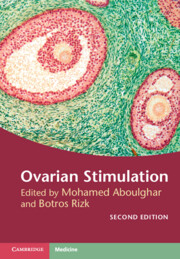Book contents
- Ovarian Stimulation
- Ovarian Stimulation
- Copyright page
- Dedication
- Contents
- Contributors
- About the Editors
- Foreword
- Preface to the first edition
- Preface to the second edition
- Section 1 Mild Forms of Ovarian Stimulation
- Section 2 Ovarian Hyperstimulation for IVF
- Chapter 6 GnRH Agonists for Ovarian Hyperstimulation
- Chapter 7 Role of GnRH Antagonist in Assisted Reproduction
- Chapter 8 Gonadotropins in Ovarian Stimulation
- Chapter 9 Egg Donation: Implications for Counseling Donor and Recipient, Donor Preparation, and Recipient Preparation
- Chapter 10 Progestin-Primed Ovarian Stimulation
- Chapter 11 Ovarian Stimulation in Poor Responders
- Section 3 Difficulties and Complications of Ovarian Stimulation and Implantation
- Section 4 Non-conventional Forms Used during Ovarian Stimulation
- Section 5 Alternatives to Ovarian Hyperstimulation and Delayed Transfer
- Section 6 Procedures before, during, and after Ovarian Stimulation
- Index
- References
Chapter 11 - Ovarian Stimulation in Poor Responders
from Section 2 - Ovarian Hyperstimulation for IVF
Published online by Cambridge University Press: 14 April 2022
- Ovarian Stimulation
- Ovarian Stimulation
- Copyright page
- Dedication
- Contents
- Contributors
- About the Editors
- Foreword
- Preface to the first edition
- Preface to the second edition
- Section 1 Mild Forms of Ovarian Stimulation
- Section 2 Ovarian Hyperstimulation for IVF
- Chapter 6 GnRH Agonists for Ovarian Hyperstimulation
- Chapter 7 Role of GnRH Antagonist in Assisted Reproduction
- Chapter 8 Gonadotropins in Ovarian Stimulation
- Chapter 9 Egg Donation: Implications for Counseling Donor and Recipient, Donor Preparation, and Recipient Preparation
- Chapter 10 Progestin-Primed Ovarian Stimulation
- Chapter 11 Ovarian Stimulation in Poor Responders
- Section 3 Difficulties and Complications of Ovarian Stimulation and Implantation
- Section 4 Non-conventional Forms Used during Ovarian Stimulation
- Section 5 Alternatives to Ovarian Hyperstimulation and Delayed Transfer
- Section 6 Procedures before, during, and after Ovarian Stimulation
- Index
- References
Summary
Controlled ovarian stimulation (COS) is an important step during in vitro fertilization (IVF) treatment that aims to produce sufficient follicles and oocytes to achieve pregnancy. Despite recent progresses in assisted reproductive technology (ART), a poor ovarian response (POR) remains one of the most challenging issues for reproductive clinicians [1]. The incidence of POR during COS has been reported to range from 5.6 percent to 35.1 percent depending on differences in the definition of poor response [1–4]. Patients with POR have higher cycle cancellation rates, lower pregnancy rates, and heavier financial burden [4–6]. In this chapter, we discuss the classification and treatments of POR.
- Type
- Chapter
- Information
- Ovarian Stimulation , pp. 101 - 108Publisher: Cambridge University PressPrint publication year: 2022



